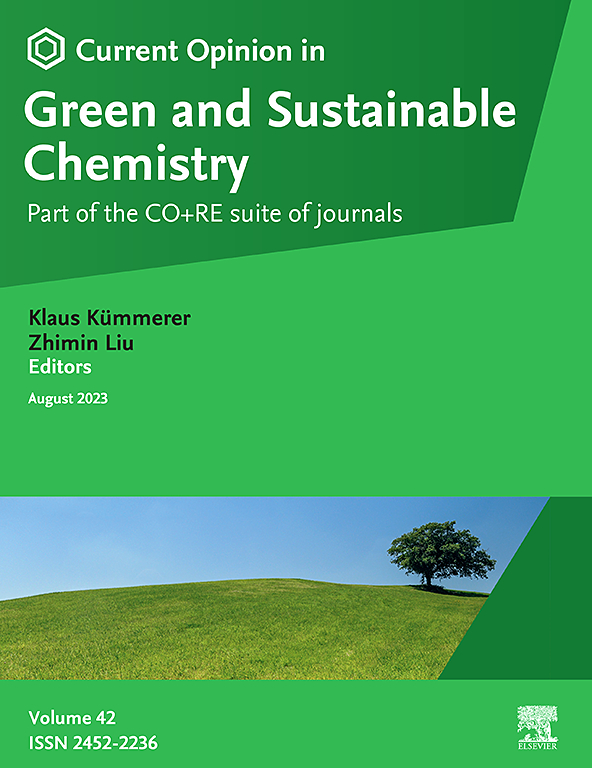Tandem plasma electrocatalysis: An emerging pathway for sustainable ammonia production
IF 9.4
2区 化学
Q1 CHEMISTRY, MULTIDISCIPLINARY
Current Opinion in Green and Sustainable Chemistry
Pub Date : 2025-02-01
DOI:10.1016/j.cogsc.2024.100986
引用次数: 0
Abstract
The Haber-Bosch process, the dominant process for industrial ammonia production, is highly energy-intensive and a major source of carbon emissions. Plasma and electrocatalysis offer viable and promising alternatives for nitrogen reduction reactions, especially when integrated with intermittent renewable electricity. However, relying solely on plasma or electrocatalysis for direct N₂ reduction presents significant challenges. Plasma technology suffers from low conversion efficiency and high energy consumption. Similarly, electrocatalysis encounters challenges with low yield and Faradaic efficiency, primarily due to the low solubility of nitrogen gas and interference of the competing hydrogen evolution reaction. A tandem process combining plasma synthesis of NOx (a mixture of NO and NO2) with the electrochemical NOx reduction reaction (eNOx−RR) can effectively use NOx as an intermediate, thereby significantly reducing the difficulty of N2 activation in plasma and enhancing the Faradaic efficiency of the subsequent electrocatalytic process. This promising solution has great potential to dramatically enhance the ammonia synthesis rate, making the tandem process a compelling technology for sustainable and decentralized ammonia synthesis under mild conditions. This review provides an insightful overview of the tandem plasma-electrocatalytic process, illustrating the reported methods for plasma-driven nitrogen activation to nitrogen oxides and discussing the recent advances and challenges in eNOx−RR, with a particularly focus on developing efficient electrocatalysts. Additionally, we discuss the systemic challenges of integrating these two processes, highlighting the importance of process optimization and the potential for ammonia production. The techno-economic and environmental impacts of the tandem process are also evaluated and compared to the Haber-Bosch process, providing insights into future development pathways for this innovative approach.
串联等离子体电催化:可持续氨生产的新兴途径
哈伯-博世工艺是工业氨生产的主要工艺,它是高度能源密集型的,也是碳排放的主要来源。等离子体和电催化为氮还原反应提供了可行且有前途的替代方案,特别是当与间歇性可再生电力相结合时。然而,仅仅依靠等离子体或电催化来直接减少N₂存在很大的挑战。等离子体技术存在转换效率低、能耗高的问题。同样,电催化也面临产率低和法拉第效率低的挑战,这主要是由于氮气的溶解度低和竞争性析氢反应的干扰。将等离子体合成NOx (NO和NO2的混合物)与电化学NOx还原反应(eNOx−RR)串联起来,可以有效地利用NOx作为中间体,从而显著降低了等离子体中N2的活化难度,提高了后续电催化过程的法拉第效率。这种有希望的解决方案具有极大的潜力,可以显着提高氨合成速率,使串联工艺成为一种在温和条件下可持续和分散的氨合成技术。这篇综述对串联等离子体电催化过程进行了深刻的概述,说明了等离子体驱动氮活化成氮氧化物的方法,并讨论了eNOx - RR的最新进展和挑战,特别侧重于开发高效的电催化剂。此外,我们讨论了整合这两个过程的系统性挑战,强调了过程优化的重要性和氨生产的潜力。对串联工艺的技术经济和环境影响进行了评估,并与Haber-Bosch工艺进行了比较,为这种创新方法的未来发展路径提供了见解。
本文章由计算机程序翻译,如有差异,请以英文原文为准。
求助全文
约1分钟内获得全文
求助全文
来源期刊

Current Opinion in Green and Sustainable Chemistry
Chemical Engineering-Catalysis
CiteScore
16.00
自引率
2.20%
发文量
140
审稿时长
103 days
期刊介绍:
The Current Opinion journals address the challenge specialists face in keeping up with the expanding information in their fields. In Current Opinion in Green and Sustainable Chemistry, experts present views on recent advances in a clear and readable form. The journal also provides evaluations of the most noteworthy papers, annotated by experts, from the extensive pool of original publications in Green and Sustainable Chemistry.
 求助内容:
求助内容: 应助结果提醒方式:
应助结果提醒方式:


